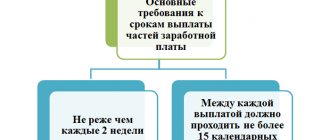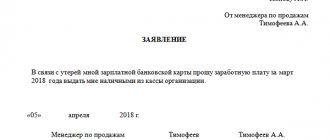What must an employer pay a posted employee?
In accordance with labor legislation, the employer must compensate the employee (Article 168 of the Labor Code of the Russian Federation):
The employer sets the procedure and standards for reimbursing employees for travel expenses independently in a collective agreement or internal regulations.
Calculation of travel allowances
In order for an accountant to correctly calculate travel allowances, first of all it is necessary to calculate the days on a business trip. This is necessary to determine the amount of daily allowance.
Here is the calculation of travel allowance (daily allowance) with an example:
The employee is sent on a business trip from February 5 to 12 (the 5th is the date of departure for the business trip, the 12th is the date of return). And so it turns out to be 8 days of business trip. This means that the employee is entitled to daily allowance for 8 days:
If the company sets the daily allowance for business trips within the Russian Federation as 700 rubles, the employee will receive a daily allowance of 5,600.00 rubles. (8 days × 700.00 rub.).
During the business trip, the employee retains his job and average earnings.
Special provisions
So, having determined the basis for calculation and the actual time worked, we calculate the average daily earnings of a specialist. The resulting figure must be multiplied by the number of days spent on a business trip.
Please note that some institutions provide additional payments up to the average salary during a business trip. This type of payment can be assigned to those specialists whose calculated average daily salary is lower than their official salary. The maximum amount of such additional payment is not limited by law. The amount is set individually, based on the financial capabilities of the organization.
IMPORTANT!
In the case of a business trip, average earnings should be calculated for the entire time, including days spent on the road, days of departure and return, downtime and delays (for example, flight delays).
This payment is recognized as the employee’s income and is subject to taxation according to the general rules. Thus, 13% of personal income tax should be withheld from the calculated amount, and insurance premiums should be charged at current rates. Let us remind you that if a specialist has the right to tax deductions, then they should also be applied when calculating tax.
Calculation of average earnings
On a business trip, average daily earnings are calculated using the formula:
The procedure for calculating average travel earnings was approved by Decree of the Government of the Russian Federation No. 922 of December 24, 2007. The calculation of average earnings includes all payments, with the exception of vacation pay, temporary disability benefits and some others.
As a general rule, the billing period is 12 calendar months preceding the month of the business trip. When calculating average earnings for business travelers, only working days are taken into account. The total number of days excludes days for which the employee received payments that are not taken into account in calculating average earnings (for example, sick leave).
Here is an example of calculating average travel earnings:
The employee was sent on a business trip from February 5 to February 8, 2021. This means that his pay period is from February 1, 2021 to January 31, 2020.
11 days of sick leave for child care and 28 days of annual leave are excluded from the calculation period.
And so the billing period is equal to 247 working days (from 02/01/2019 to 01/31/2020) minus 11 days and minus 28 days = 208 working days.
During the pay period, the employee received:
- RUB 700,000.00 - wage;
- RUB 50,000.00 – vacation pay;
- RUB 10,000.00 - due to temporary disability.
Average daily earnings:
RUB 3,365.38 (RUB 700,000.00 / 208 working days).
Payment for the trip will be for 4 days:
RUB 13,461.52 (RUB 3,365.38 × 4 days).
The calculation of travel allowances abroad differs from a Russian business trip only in the amount of daily allowances.
Average daily earnings are calculated the same way, regardless of the country of travel.
Calculation of salaries and insurance contributions
Settings in 1C for calculating payment during a business trip
From June 1, 2021, when paying income to an individual through a bank, payment documents must indicate the code of the type of income for the purposes of enforcement proceedings. And also provide a breakdown of the amount of deduction from income, if any (Part 5.1, Article 70 of Federal Law No. 229-FZ dated October 2, 2007, Bank of Russia Directive No. 5286-U dated October 14, 2019).
To auto-substitute the income code in the Bank Statement, you need to fill out the Type of Income in the Accruals .
- Automatic substitution of income payment code in the statement
- Reminder of codes for income paid to individuals
- Salary payment codes in payment documents
- Difficulties in using income type codes in payment documents
To be able to calculate average earnings during a business trip, create an accrual type of the same name in the Accruals , which can be opened from the Salaries and Personnel section - Directories and settings - Salary settings - Payroll calculation - Accruals. Next, click the Create .
Please pay attention to filling out the fields:
Personal income tax section :
- switch taxed ;
- income code 2000 - remuneration for performing labor or other duties; salary and other taxable payments to military personnel and equivalent persons;
- Income category - Salary ;
Section Insurance premiums :
- Type of income - Income entirely subject to insurance premiums ;
Section Income tax, type of expense under Art. 255 Tax Code of the Russian Federation :
- the switch is taken into account in labor costs under item - paragraphs. 6, art. 255 of the Tax Code of the Russian Federation : the amount of average earnings accrued to employees, retained for the duration of their performance of state and (or) public duties and in other cases provided for by the labor legislation of the Russian Federation;
- The checkbox Included in the basic accruals for calculating the “Regional coefficient” and “Northern surcharge” accruals does not need to be set for the Accrual Payment for time on a business trip , since these accruals have already been taken into account to calculate the payment.
Section Reflection in accounting
- The method of reflection is not established. In this case, payment for the business trip will be charged to the expense account set in the Expense Accounting of the Employees directory for the salary of the employee to whom it is accrued. PDF
Payment for the duration of a business trip is part of the salary, therefore in accounting it is reflected as part of labor costs (clause 8 of PBU 10/99):
- Dt of the cost account, according to which the employee’s salary is calculated;
- CT “Settlements with personnel for remuneration” (chart of accounts 1C).
In NU, the accrued average earnings during a business trip are also taken into account in labor costs (clause 6 of Article 255 of the Tax Code of the Russian Federation), the composition of direct or indirect expenses. Whether the costs of payment during an employee’s business trip are classified as direct or indirect expenses depends on where his basic salary is allocated according to the accounting policy.
In 1C, the accrued amount will be reflected in the salary account with the BU and NU settings specified in the Employees in the Expense Accounting .
Calculation of payment for time on a business trip
Payment for time on a business trip is calculated using the Payroll in the Salaries and Personnel section - Salary - All accruals - Create button - Payroll.
The document states:
- Salary for —the month for which the employee’s salary is calculated;
- from - last day of the month.
By clicking the Add , you must select the employee who will be paid for the time on a business trip. Accrue button to select:
- Accrual Payment based on salary - indicate the number of days worked at the workplace, minus days on a business trip (calculate manually). The program will automatically calculate the amount.
- Accrual Payment for time on a business trip - indicate the calculated amount. The calculation of payment (average earnings) must be done independently, for example, in an Excel table.
All amounts accrued to an employee can be viewed and, if necessary, adjusted in the form using the Accrued .
- personal income tax column is the amount of calculated personal income tax.
The personal income tax link in the personal displays the cumulative tax calculation for the employee for the current tax period.
The date of actual receipt of income in the form of wages is considered to be the last day of the month for which he was accrued income for work duties performed in accordance with the employment agreement (contract) (clause 2 of Article 223 of the Tax Code of the Russian Federation).
Postings according to the document
The document generates transactions:
- Dt Kt - salary calculation for time worked, except for business trips;
- Dt Kt - calculation of average earnings for days of business trip;
- Dt Kt 68.01 - calculation of personal income tax from the total amount of salary;
- Dt Kt 69.01 - calculation of contributions to the Social Insurance Fund;
- Dt Kt 69.03.1 - calculation of contributions to the FFOMS;
- Dt Kt 69.11 - calculation of contributions to NS and PZ;
- Dr Kt 69.02.7 - calculation of contributions to the Pension Fund.
Documenting
The organization must approve the forms of primary documents, including those for calculating payment for the trip. In 1C: Accounting 8.3 this form is not provided, therefore the organization must develop and approve it independently, in accordance with the requirements of Art. 9 of the Federal Law of December 6, 2011 N 402-FZ.
Income tax return
In our example, the salary of Mikhailov P.A. is taken into account on account 26 “General business expenses” and in tax accounting refers to indirect (other) expenses.
In the income tax return, the costs of wages and insurance premiums accrued from them will be reflected in indirect expenses only after the Closing of accounts 20, 23, 25, 26 is carried out in the Closing of the month procedure: PDF
- Sheet 02 Appendix No. 2 page 040 “Indirect costs - total”: wages;
- compensation for unused vacation;
- insurance premiums;
- insurance premiums.
Test yourself! Take a test on this topic using the link >>
See also:
- Salary settings in 1C
- Payroll
- Personal income tax accounting operation in 1C 8.3: how to fill out
- Accrual of vacation pay
- Compensation for unused vacation
Did the article help?
Get another secret bonus and full access to the BukhExpert8 help system for 14 days free of charge
Business trip on a day off
If an employee is sent on a business trip on a day off, then this procedure applies.
For example, an employee leaves on a business trip on Sunday in order to attend a meeting on Monday at 10 a.m. Or another example, when an employee worked the whole week on a business trip from Monday to Friday, but bought a return ticket only for late Friday evening and arrived at his destination on Saturday.
are not paid for weekends . For the weekend, the employee will receive only daily allowance .
If an employee worked on a day off that fell on a business trip, then such a day must be paid double . If, according to the employee’s normal schedule, this day off for everyone is a normal working day for the business traveler, he is paid according to the average daily earnings.







